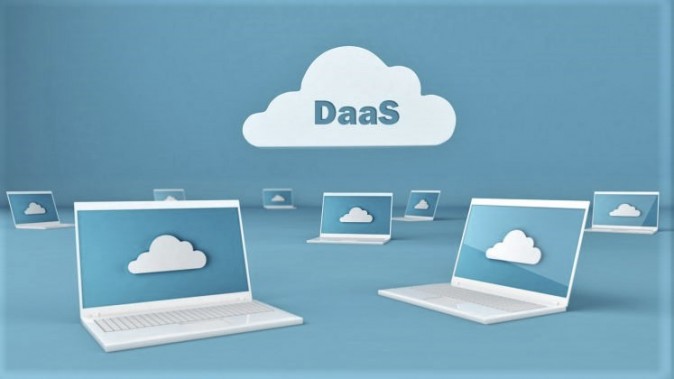Blog
What is Desktop as a Service (DaaS)?

What is Desktop as a Service (DaaS)?
Desktops-as-a-Service or simply DaaS, securely delivers virtual apps and desktops from the cloud to any device or location. Desktops-as-a-Service or simply DaaS, is the delivery of a fully managed virtual desktop instance (VDI), hosted on cloud infrastructure. DaaS enables users to access corporate applications and data via a familiar Microsoft Windows desktop experience on almost any device connected to the internet. DaaS offers a simple and predictable pay-as-a-go subscription model, making it easy to scale up or down on-demand. This service is easy to manage, simplifying many of the IT admin tasks of desktop solutions.
Not only does this provide an end-user experience fitting for the modern workplace, DaaS also has a range of benefits to technology teams including improved security, disaster recovery, and easy management of software updates, reduces support overheads and simplified provisioning.
How does DaaS Work?
Desktops as a Service (DaaS) delivers virtual applications and desktop services via a public or private cloud service. Your workforce can access this service through an internet connection via an html-based web browser or a secure application downloaded to a device such as a laptop, desktop, thin client or tablet.
DaaS is offered as a subscription service and is multitenant in nature. The backend virtual desktop infrastructure (VDI), including the virtual machines that run desktop operating systems, is hosted by a third-party cloud provider. The DaaS provider then streams the virtual desktops to a customer’s end-user devices.
DaaS providers manage the VDI deployment, as well as the maintenance, security, upgrades, data backup, and storage. And the customer manages the applications and desktop images. DaaS is a good choice for organizations that don’t want to invest in and manage their own on-premises VDI solution.
Why DaaS?
Employees of any organization expect to access their work from anywhere on any device. And companies are looking for a low-cost, simple solution to securely deliver the apps and desktops people need to get their work done. Traditional PC environments are burdened with IT management challenges as simple as employee password resets and as difficult as updating security patches and updates that impact user experience and productivity as well as take up valuable time for IT administrators.
While many customers are turning to virtualizing applications and desktops, the perceived complexity and capital investment have industries looking to a simplified solution that works within an operational expense structure.
Desktops as a Service (DaaS) can be a viable solution for customers that like the centralization, security and management of VDI yet are attracted to the simplicity of having a professional organization perform basic desktop management on their behalf. DaaS offers many advantages to IT by simplifying operations and delivering Windows desktops and apps securely to its workforce
Benefits of DaaS
- The Modern Workplace: Digital transformation is redefining what we think about the workplace. At the heart of this evolution is technology and the introduction of digital-first natives into the workplace. Millennials expect workplace technology to work as good as or better than their own devices. They are comfortable with technology and count on their employers to provide them with the tools they need to do their job. Allowing staff to work remotely and via their own devices is a surefire way to attract and retain the best talent.
- Flexibility: Employees, seasonal workers and contractors can securely access their applications, remote desktops, and data from anywhere on cost effective devices, keeping them productive, no matter where they work.
- Scalability: Rapidly scale up applications and desktops when needed and then scale down when you no longer need them, keeping IT costs inline. This can include phases during a merger or acquisition (M&A), staffing temporary workers during peak seasons, managing contractors (developers), or deploying branch offices.
- Business continuity: DaaS can be a simple way to support a disaster recovery (DR) plan. Respond quickly enable secure remote access to apps and desktops for your workforce and stay up and running in the event of a natural disaster, pandemic or any other unforeseen event. Your employees stay safe and your organization stays productive. DaaS makes it easy to quickly add users when needed and pay for what you use.
- Cost: Pay for only what you use through monthly or yearly subscription models. Plus reduce capital expenses and enjoy more predictable operational expenses.
- Security: DaaS provides a secure access point for users and simplifies desktop and app management processes and procedures. With access to applications and desktops in the cloud, data is securely stored and protected against data loss or device theft.
- Management: With an increasingly dispersed workforce, rolling out new applications or patching existing software has become more of a logistical problem than a technical one. Trying to coordinate people bringing in physical devices to be patched is a real issue for many companies, something which is eliminated completely with DaaS. You operate on one central image (or a small number of images based on persona), a change is made once, and everyone is on the latest version. It removes the need to standardize builds of end-user computer hardware as DaaS will run on almost any device no matter its configuration.
- Control: DaaS helps you manage the risks that naturally come with giving your staff the freedom to work anywhere and on any device. It enables you to control the essentials such as data access and compliance without being overly restrictive. You no longer have to worry about what data is held on a user’s device as the data remains in the data center at all times. This gives you control over all company assets because access can be revoked with the touch of a button.